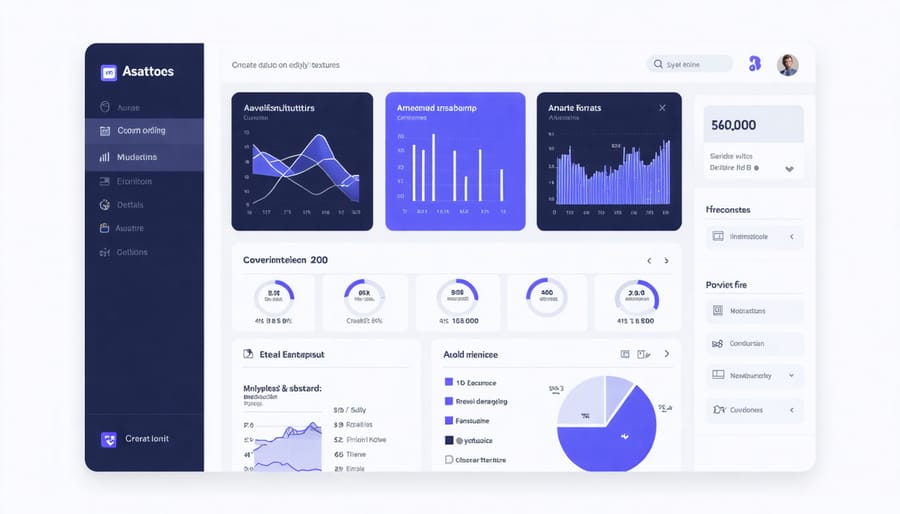Transform your real estate investment decisions with financial navigator software – the cornerstone of modern real estate finance tools that streamline portfolio management and amplify returns. This sophisticated technology revolutionizes how property professionals analyze markets, track investments, and optimize cash flow, all while reducing the complexity of financial decision-making.
Gone are the days of juggling multiple spreadsheets and manual calculations. Today’s financial navigator platforms integrate real-time market data, automated valuation models, and predictive analytics to deliver instant insights that drive smarter investment choices. Whether you’re managing a single property or overseeing a diverse portfolio, these intelligent systems transform raw data into actionable strategies, helping you identify opportunities, mitigate risks, and maximize property performance with unprecedented precision.
By centralizing financial data, automating routine tasks, and providing customizable reporting dashboards, financial navigator software doesn’t just save time – it fundamentally enhances the quality of investment decisions while ensuring compliance with industry regulations. For real estate professionals seeking a competitive edge in today’s dynamic market, this technology has become an indispensable ally in the pursuit of sustainable growth and profitability.
What Makes Financial Navigator Software Essential in Modern Real Estate
Real-Time Portfolio Analysis
The real-time portfolio analysis feature transforms how investors monitor and manage their property investments. Through an intuitive dashboard, users can instantly access comprehensive insights into their entire property portfolio’s performance. The software continuously tracks key metrics such as cash flow, ROI, property appreciation, and occupancy rates, presenting them through easy-to-understand visualizations and reports.
What sets this functionality apart is its ability to aggregate data from multiple sources in real-time. Whether it’s rental income, maintenance costs, or market comparisons, the system automatically updates these figures, providing investors with the most current view of their portfolio’s health. Users can drill down into individual properties or zoom out for a bird’s-eye view of their entire investment landscape.
The analysis tools also include predictive analytics capabilities, helping investors identify trends and potential opportunities. By comparing current performance against historical data and market benchmarks, the software highlights areas for optimization and flags potential issues before they become problems. This proactive approach to portfolio management enables investors to make data-driven decisions quickly and confidently, ultimately maximizing their investment returns while minimizing risks.

Automated Financial Forecasting
Financial navigator software has revolutionized the way real estate professionals forecast market trends and investment outcomes through AI-powered predictive analytics. These sophisticated tools analyze historical data, market indicators, and property-specific metrics to generate accurate financial projections that help investors make informed decisions.
The automated forecasting capabilities go beyond simple spreadsheet calculations, incorporating multiple variables such as interest rate fluctuations, market volatility, and regional economic indicators. Real estate professionals can now generate detailed cash flow projections, ROI estimates, and risk assessments in minutes rather than hours.
What makes these tools particularly valuable is their ability to adapt and learn from new data. As market conditions change, the software automatically adjusts its forecasts, providing users with real-time updates and scenario analysis. This dynamic approach to financial modeling helps investors quickly identify potential opportunities and risks, while maintaining a competitive edge in fast-moving markets.
The system can also flag potential issues before they become problems, allowing for proactive rather than reactive decision-making in property investments.
Key Features That Drive Investment Success
Cash Flow Management Tools
Modern financial navigator software offers robust cash flow management tools specifically designed for real estate operations. These tools enable property owners and managers to maintain precise control over their income streams and expenses while providing valuable insights for optimizing financial performance.
The software typically includes automated rent collection features that streamline payment processing and provide real-time tracking of incoming funds. Users can monitor late payments, set up automatic late fee calculations, and generate detailed reports on payment histories. This automation significantly reduces the administrative burden while improving collection rates.
For expense management, these platforms offer categorized tracking of property-related costs, including maintenance, utilities, insurance, and mortgage payments. The software can generate cash flow forecasts based on historical data and upcoming expenses, helping users make informed decisions about property improvements or investments.
Many solutions also include customizable dashboards that display key performance indicators (KPIs) such as net operating income, vacancy rates, and expense ratios. These visual tools make it easier to identify trends and potential issues before they impact profitability.
Advanced features often include scenario planning capabilities, allowing users to model different financial situations and their potential impacts on cash flow. This functionality is particularly valuable when evaluating property improvements or considering refinancing options.
Risk Assessment Algorithms
Financial navigator software employs sophisticated risk assessment algorithms to help real estate investors make informed decisions. These algorithms analyze multiple factors, including market volatility, property value trends, interest rate fluctuations, and regional economic indicators to generate comprehensive risk profiles.
The software typically uses a three-tier evaluation system. First, it examines historical data patterns to identify potential investment risks. Then, it applies predictive modeling to forecast future market conditions. Finally, it combines these insights with real-time market data to create dynamic risk scores.
For property investors, the risk assessment feature presents information through intuitive visualizations, including heat maps, risk matrices, and probability curves. This makes complex risk factors easier to understand and act upon. The software also generates customized risk tolerance profiles based on individual investment goals and financial circumstances.
What sets modern financial navigator systems apart is their ability to factor in location-specific risks such as natural disasters, zoning changes, and neighborhood development plans. The algorithms continuously update risk assessments as new data becomes available, ensuring investors always have access to the most current risk analysis for their real estate portfolios.
Through machine learning capabilities, these systems become more accurate over time, learning from actual market outcomes to refine their risk predictions and recommendations.

Market Analysis Integration
Modern financial navigator software excels at seamlessly integrating real-time market data, providing investors and real estate professionals with comprehensive market insights at their fingertips. These platforms aggregate data from multiple sources, including MLS listings, property value trends, neighborhood analytics, and broader economic indicators, creating a unified view of market conditions.
The software’s analysis capabilities go beyond basic number-crunching, offering predictive analytics that help users identify emerging market trends and potential investment opportunities. Users can visualize market data through customizable dashboards, interactive charts, and heat maps, making complex market information more digestible and actionable.
Key features typically include automated valuation models (AVMs), rental market analysis, and comparative market analysis (CMA) tools. These components work together to provide accurate property valuations, forecast potential returns, and assess market competition. The integration of local economic indicators, such as employment rates and population growth, adds another layer of insight, helping users make more informed investment decisions.
For real estate professionals, this market intelligence becomes invaluable when advising clients or making strategic portfolio decisions, ensuring they stay ahead in a competitive market.
Implementation Strategies for Maximum ROI
Integration with Existing Systems
Integrating financial navigator software with your existing real estate management systems requires a strategic approach to ensure smooth data flow and operational efficiency. Start by conducting a thorough audit of your current software ecosystem, identifying key touchpoints where integration is crucial. Most modern financial navigator platforms offer API connectivity, making it easier to sync with property management software, accounting tools, and CRM systems.
Begin with data migration planning, ensuring all historical financial records and property information can be transferred accurately. Many platforms provide built-in migration tools and dedicated support teams to assist during this phase. Remember to implement robust digital security measures throughout the integration process.
Create a testing environment before full deployment to verify data accuracy and system compatibility. This allows you to identify and resolve potential conflicts without disrupting daily operations. Train your team on the new integrated system, focusing on new workflows and features that enhance productivity.
Most financial navigator solutions offer customizable integration options, allowing you to maintain existing workflows while adding new capabilities. Consider starting with core functionalities like payment processing and financial reporting before expanding to more advanced features. Regular system audits and updates ensure continued compatibility and optimal performance across your integrated technology stack.

Training and Adoption Best Practices
Successful implementation of financial navigator software requires a strategic approach to training and adoption. Start by identifying key team members who will serve as software champions, responsible for mastering the platform and supporting their colleagues during the transition.
Create a phased training schedule that begins with basic functionalities and gradually progresses to advanced features. This prevents overwhelming users and allows for better retention of information. Schedule regular training sessions focusing on specific modules, such as property analysis tools or investment tracking features.
Encourage hands-on practice by setting up sandbox environments where team members can experiment without fear of affecting live data. Document common workflows and create quick reference guides tailored to your organization’s specific needs.
To boost adoption rates, showcase early wins and real-world benefits through case studies from within your organization. For example, highlight how the software helped close deals faster or identified profitable investment opportunities that might have been missed otherwise.
Establish clear performance metrics to track adoption progress and identify areas where additional support may be needed. Regular feedback sessions can help address challenges and ensure the software meets team requirements.
Remember to maintain ongoing training resources for new hires and refresher courses for existing team members. This ensures consistent usage and maximizes the return on your software investment.
Future-Proofing Your Real Estate Investment Strategy
Emerging Technologies and Integration
Financial navigator software is rapidly evolving to incorporate cutting-edge technologies that are transforming how real estate professionals manage their investments. As one of the leading real estate tech trends, artificial intelligence and machine learning capabilities are being integrated to provide more accurate property valuations and market predictions.
Blockchain technology is making its way into financial navigator platforms, offering enhanced security for transactions and smart contracts. This integration allows for more transparent and efficient property dealings while reducing the risk of fraud. Additionally, cloud-based solutions are becoming standard, enabling real-time collaboration and access to financial data from any device.
Voice-activated interfaces and natural language processing are emerging as game-changing features, allowing users to query their financial data and receive instant insights through simple voice commands. The integration of augmented reality (AR) is also on the horizon, promising to revolutionize how investors visualize property financial data and market analytics.
Internet of Things (IoT) sensors are being incorporated to provide real-time property performance metrics, helping investors make data-driven decisions about their real estate portfolios. These technological advances are making financial navigator software more intuitive, powerful, and indispensable for modern real estate professionals.
Adapting to Market Changes
In today’s rapidly evolving real estate market, staying ahead of changes is crucial for success. Financial navigator software serves as a dynamic tool that helps professionals and investors adapt to market fluctuations in real time. The software continuously monitors market indicators, property values, and economic trends, providing users with actionable insights to adjust their strategies accordingly.
One of the key features is the automatic recalibration of investment models based on changing market conditions. When interest rates shift or property values fluctuate, the software automatically updates financial projections and risk assessments, enabling quick decision-making. This responsiveness is particularly valuable during market volatility, where delayed reactions can mean missed opportunities or increased risks.
The software’s predictive analytics capabilities use historical data and current market trends to forecast potential market shifts. Users receive alerts about emerging opportunities or potential risks, allowing them to proactively adjust their investment strategies. For instance, if the software detects a trending shift in a particular neighborhood’s property values, it can suggest portfolio adjustments before the market fully responds.
Additionally, financial navigator software helps users stress-test their investment strategies against various market scenarios. By simulating different economic conditions – from market downturns to property boom cycles – investors can develop robust contingency plans. This feature proves invaluable for maintaining portfolio stability during unexpected market changes and ensuring long-term investment success.
Financial navigator software has become an indispensable tool in modern real estate operations, transforming how professionals and investors manage their financial decisions and property portfolios. By centralizing data analysis, streamlining operations, and providing real-time insights, these platforms enable users to make more informed and strategic investment choices.
The key takeaways for successful implementation include starting with a clear assessment of your specific needs, ensuring proper team training, and gradually scaling usage as comfort levels increase. Remember that the most effective implementations often begin with core features before expanding to more advanced functionalities.
Looking ahead, financial navigator software will continue to evolve with emerging technologies, offering even more sophisticated analysis tools and automation capabilities. The integration of artificial intelligence and machine learning promises to deliver more accurate predictions and personalized recommendations for property investments.
For real estate professionals and investors, staying competitive in today’s market means embracing these digital tools. Whether you’re managing a single property or overseeing a vast portfolio, financial navigator software provides the framework needed to optimize returns, minimize risks, and maintain compliance with regulatory requirements.
Success with these platforms ultimately depends on commitment to consistent use, regular data updates, and ongoing education about new features and capabilities. By following these guidelines and maintaining a proactive approach to financial management, users can maximize the value of their investment in financial navigator software.